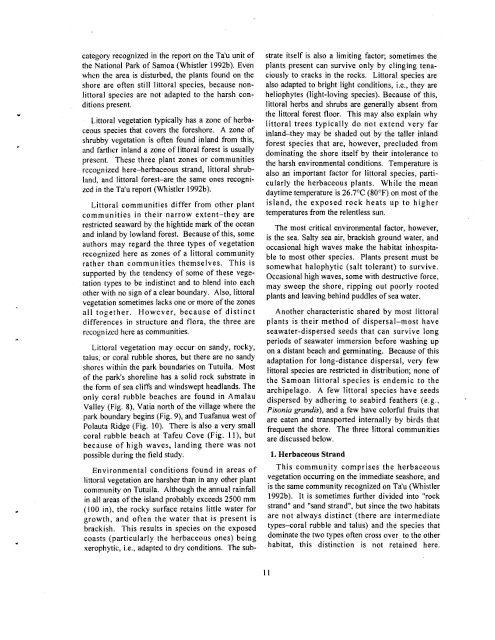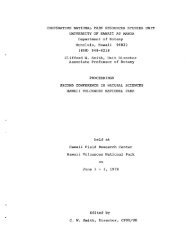american samoa - University of Hawaii at Manoa
american samoa - University of Hawaii at Manoa
american samoa - University of Hawaii at Manoa
Create successful ePaper yourself
Turn your PDF publications into a flip-book with our unique Google optimized e-Paper software.
c<strong>at</strong>egory recognized in the report on the Ta'u unit <strong>of</strong><br />
the N<strong>at</strong>ional Park <strong>of</strong> Samoa (Whistler 1992b). Even<br />
when the area is disturbed, the plants found on the<br />
shore are <strong>of</strong>ten still littoral species, because non-<br />
littoral species are not adapted to the harsh con-<br />
ditions present.<br />
Littoral veget<strong>at</strong>ion typically has a zone <strong>of</strong> herba-<br />
ceous species th<strong>at</strong> covers the foreshore. A zone <strong>of</strong><br />
shrubby veget<strong>at</strong>ion is <strong>of</strong>ten found inland from this,<br />
and farther inland a zone <strong>of</strong> littoral forest is usually<br />
present. These three plant zones or communities<br />
recognized here-herbaceous strand, littoral shrub-<br />
land, and littoral forest-are the same ones recogni-<br />
zed in the Ta'u report (Whistler 1992b).<br />
Littoral communities differ from other plant<br />
communities in their narrow extent-they are<br />
restricted seaward by the hightide mark <strong>of</strong> the ocean<br />
and inland by lowland forest. Because <strong>of</strong> this, some<br />
authors may regard the three types <strong>of</strong> veget<strong>at</strong>ion<br />
recognized here as zones <strong>of</strong> a littoral community<br />
r<strong>at</strong>her than communities themselves. This is<br />
supported by the tendency <strong>of</strong> some <strong>of</strong> these vege-<br />
t<strong>at</strong>ion types to be indistinct and to blend into each<br />
other with no sign <strong>of</strong> a clear boundary. Also, littoral<br />
veget<strong>at</strong>ion sometimes lacks one or more <strong>of</strong> the zones<br />
all together. However, because <strong>of</strong> distinct<br />
differences in structure and flora, the three are<br />
rccognited here as communities.<br />
Littoral veget<strong>at</strong>ion may occur on sandy, rocky,<br />
talus, or coral rubble shores, but there are no sandy<br />
shores within the park boundaries on Tutuila. Most<br />
<strong>of</strong> the park's shoreline has a solid rock substr<strong>at</strong>e in<br />
the form <strong>of</strong> sea cliffs and windswept headlands. The<br />
only coral rubble beaches are found in Amalau<br />
Valley (Fig. 8), V<strong>at</strong>ia north <strong>of</strong> the village where the<br />
park boundary begins (Fig. 9), and Tuafanua west <strong>of</strong><br />
Polauta Ridge (Fig. 10). There is also a very small<br />
coral rubble beach <strong>at</strong> Tafeu Cove (Fig. ll), but<br />
because <strong>of</strong> high waves, landing there was not<br />
possible during the field study.<br />
Environmental conditions found in areas <strong>of</strong><br />
littoral veget<strong>at</strong>ion are harsher than in any other plant<br />
community on Tutuila. Although the annual rainfall<br />
in all areas <strong>of</strong> the island probably exceeds 2500 mm<br />
(I00 in), the rocky surface retains little w<strong>at</strong>er for<br />
growth, and <strong>of</strong>ten the w<strong>at</strong>er th<strong>at</strong> is present is<br />
brackish. This results in species on the exposed<br />
coasts (particularly the herbaceous ones) being<br />
xerophytic, i.e., adapted to dry conditions. The sub-<br />
str<strong>at</strong>e itself is also a limiting factor; sometimes the<br />
plants present can survive only by clinging tena-<br />
ciously to cracks in the rocks. Littoral species are<br />
also adapted to bright light conditions, i.e., they are<br />
heliophytes (light-loving species). Because <strong>of</strong> this,<br />
littoral herbs and shrubs are generally absent from<br />
the littoral forest floor. This may also explain why<br />
littoral trees typically do not extend very far<br />
inland-they may be shaded out by the taller inland<br />
forest species th<strong>at</strong> are, however, precluded from<br />
domin<strong>at</strong>ing the shore itself by their intolerance to<br />
the harsh environmental conditions. Temper<strong>at</strong>ure is<br />
also an important factor for littoral species, parti-<br />
cularly the herbaceous plants. While the mean<br />
daytime temper<strong>at</strong>ure is 26.7"C (80°F) on most <strong>of</strong> the<br />
island, the exposed rock he<strong>at</strong>s up to higher<br />
temper<strong>at</strong>ures from the relentless sun.<br />
The most critical environmental factor, however,<br />
is the sea. Salty sea air, brackish ground w<strong>at</strong>er, and<br />
occasional high waves make the habit<strong>at</strong> inhospita-<br />
ble to most other species. Plants present must be<br />
somewh<strong>at</strong> halophytic (salt tolerant) to survive.<br />
Occasional high waves, some with destructive force,<br />
may sweep the shore, ripping out poorly rooted<br />
plants and leaving behind puddles <strong>of</strong> sea w<strong>at</strong>er.<br />
Another characteristic shared by most littoral<br />
plants is their method <strong>of</strong> dispersal-most have<br />
seaw<strong>at</strong>er-dispersed seeds th<strong>at</strong> can survive long<br />
periods <strong>of</strong> seaw<strong>at</strong>er immersion before washing up<br />
on a distant beach and germin<strong>at</strong>ing. Because <strong>of</strong> this<br />
adapt<strong>at</strong>ion for long-distance dispersal, very few<br />
littoral species are restricted in distribution; none <strong>of</strong><br />
the Samoan littoral species is endemic to the<br />
archipelago. A few littoral species have seeds<br />
dispersed by adhering to seabird fe<strong>at</strong>hers (e.g.,<br />
Pisonia grandis), and a few have colorful fruits th<strong>at</strong><br />
are e<strong>at</strong>en and transported internally by birds th<strong>at</strong><br />
frequent the shore. The three littoral communities<br />
are discussed below.<br />
1. Herbaceous Strand<br />
This community comprises the herbaceous<br />
veget<strong>at</strong>ion occurring on the immedi<strong>at</strong>e seashore, and<br />
is the same community recognized on Ta'u (Whistler<br />
1992b). It is sometimes further divided into "rock<br />
strand" and "sand strand", but since the two habit<strong>at</strong>s<br />
are not always distinct (there are intermedi<strong>at</strong>e<br />
types-coral rubble and talus) and the species th<strong>at</strong><br />
domin<strong>at</strong>e the two types <strong>of</strong>ten cross over to the other<br />
habit<strong>at</strong>, this distinction is not retained here.
















